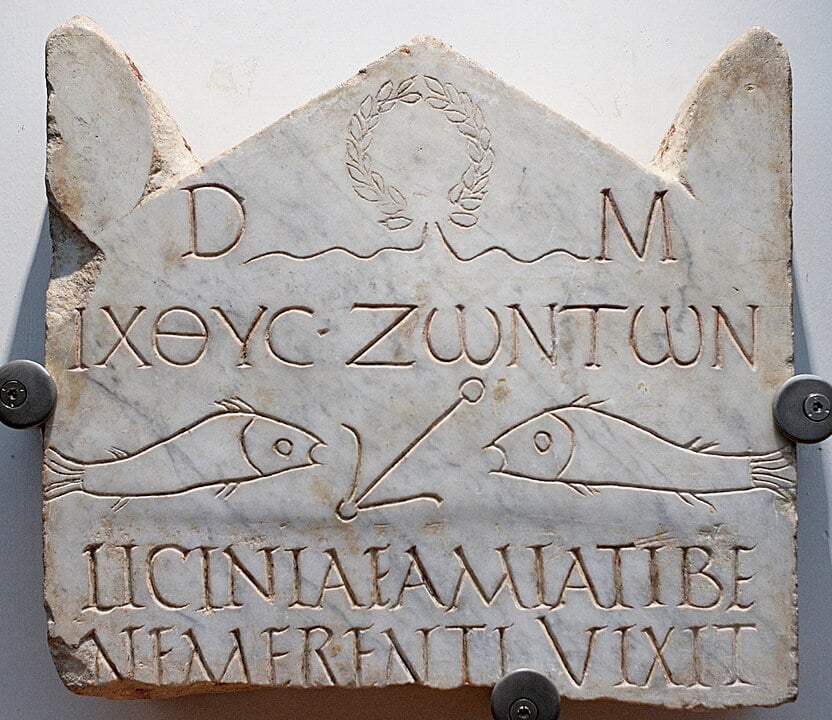

The humble fish, or ichthys (ἰχθύς) in Greek, was a symbol that played a crucial role in the early years of Christian history when people were afraid of telling others that they believed in this new religion.
The fish (ichthys) was a symbol of Christian faith and a secret code. It became a profound declaration of the early followers of Jesus, who abandoned idols and believed in this new religion.
This simple yet effective way of expressing their belief helped early Christians avoid persecution while expressing their admiration for their Savior.
Imagine walking through the streets of ancient Rome under the shadow of constant fear and persecution. You meet a stranger, unsure if they share your faith or pose a threat. Instead of words, you draw a simple arc in the dirt. If the other person completes it with another arc to form the outline of a fish, you’ve found an ally; a person whose beliefs are as radical as yours. If not, you’d be safe, as no one would know why you completed this ‘random’ arc.
As you can understand, this was no ordinary doodle—it was the ichthys, the Greek word for “fish,” and it carried a secret message.
The word ichthys is an acronym for the Greek phrase “Ιησούς Χριστός, Θεού Υιός, Σωτήρ,” (Iesous Christos, Theou Yios, Soter) meaning “Jesus Christ, God’s Son, Savior.”
Each letter represented a cornerstone of Christian belief: Ι (Iota) for Iesous (Jesus), Χ (Chi) for Christos (Christ), Θ (Theta) for Theou (of God), Υ (Upsilon) for Yios (Son), and Σ (Sigma) for Soter (Saviour).
This acronym wasn’t just clever; it saved the lives of thousands of early Christians who had seen many of their fellow believers being persecuted, thrown into jail, and even killed simply because of their faith. During the Roman Empire’s brutal crackdowns on Christians in the 2nd and 3rd centuries, this symbol allowed believers to identify with each other without saying a single word. It was Christianity’s version of a secret handshake—simple yet profoundly useful.
The choice of the fish as a symbol was not simply a coincidence of the Greek language. It was also deeply rooted in Scripture. Biblically, it reminded believers of stories that were foundational to Christian teachings.

Jesus called for His disciples to be “fishers of men” (Matthew 4:19), making the fish an apt metaphor for spreading His message. The miracle of feeding 5,000 people with loaves and fishes (Matthew 14:13–21) was another example of how Christians saw the fish as a symbol of abundance and divine protection. Early church fathers, like Tertullian, even linked the fish to baptism, describing Christians as “little fish” born in water—a poetic image that made Christians familiar with this element.
Practically speaking, the fish symbol was already familiar in Greco-Roman culture as it was a popular motif for many decorative elements in Greek and later Roman households and public places. This allowed Christians to use it discreetly without raising any suspicion. Its simplicity was another key element, making it easy for them to draw quickly—something ideal for secret communication during these hard times of persecution.
The ichthys also adorned tombs, meeting places, and catacombs across the Mediterranean world. Archaeologists have uncovered fish engravings in places like the Catacombs of St. Sebastian and Domitilla in Rome, and the ancient Greek city of Ephesus in modern-day Turkey. In some cases, the symbol appeared as an eight-spoked wheel formed by overlapping the letters ΙΧΘΥΣ.
Fast forward to today, and you’ll find the ichthys on car bumpers, jewelry, and even tattoos of devout Christians. Obviously, its modern usage is more decorative than covert, but it remains an important part of Christian identity. It’s fascinating to think that what once was literally a lifeline for persecuted believers now is used as an open declaration of faith in public spaces.
